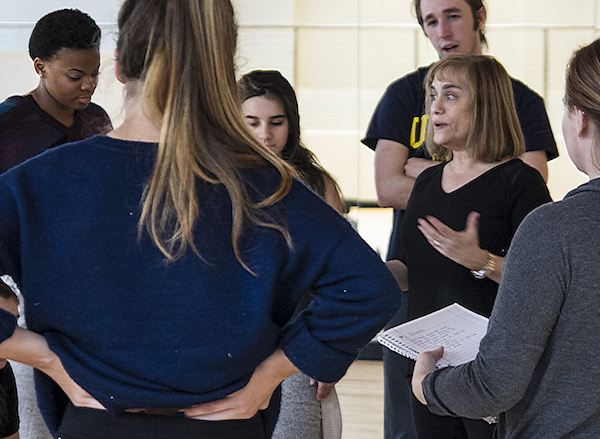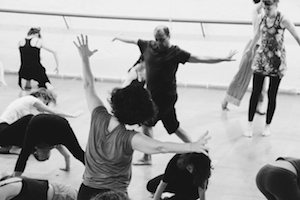|
UNCG'S Center for Women's Health and Wellness
is supporting the development of a project titled
Kinetic Awareness® and Women with Breast Cancer Project.
The purpose of this project is to develop a Kinetic Awareness ® movement program for women with breast cancer. During the Fall 2007 Dr. Jill Green and her assistants will teach a group of women Kinetic Awareness ®. Dr. Green will conduct a qualitative investigation (case studies), exploring how the use of this somatic practice may help women with breast cancer, particularly with the side effects of their treatments. The class will meet two times a week for seven weeks. Each class will be 90 minutes long. Class will begin September 24th and go through the week of November 18. We need 10 participants by August 24.
Kinetic Awareness ® is one of a number of somatic practices (body-mind approaches) currently being explored for their health benefits. Research on the use of Polarity Therapy (Mustian et al., 2007), Tai Chi Chuan (Mustian, Katula, and Zhao, 2006; Mustian, Palesh, and Flecksteiner, 2007), relaxation training, meditation, social support groups, music therapy, exercise (Mustian, Katula, and Gill, 2002; Mustian et al., 2007; Mustian et al., 2006), yoga (Mustian et al., 2007), and dance and movement (Sandel et al., 2005) have been particularly useful with the side effects of treatment and quality of life of women with breast cancer. Kinetic Awareness ® promises to provide many benefits as well. As described in Green (1992),
Somatic education provides a wealth of body-mind systems and approaches that allow us to become aware of our inner psycho-physical selves and movement capabilities. This focus on an experiential understanding of the holistic functioning of mind and body may enhance performance and expressiveness. Kinetic Awareness® is one approach to somatic education that provides an opportunity to explore movement potential and develop movement possibilities. This system of body-mind reeducation, developed by Elaine Summers, focuses on increased movement efficacy and ease through heightened awareness of automatic and conscious movement. It enhances the understanding the body uses to communicate with ourselves. (p. 61)
|
Because this system uses graduated rubber balls to enhance body awareness and release excess muscular tension, Kinetic Awareness ® is often referred to as "e; the ball work."e; Balls, placed under various parts of the body, provide contact with inner sensations, bringing to awareness inefficient patterns and psycho-physical processes.
Jill Green, Ph.D. ( jillgreen@uncg.edu, 334-3266) is an Associate Professor of Dance at UNCG. She is certified to teach Kinetic Awareness ®. Additionally, she is certified as a Kinetic Awareness Master Teacher (able to teach teachers of the work) and is a specialist in a number of somatic practices and movement approaches.
THE UNIVERSITY OF NORTH CAROLINA AT GREENSBORO
DEPARTMENT OF DANCE
References
Green, J. (1992). The use of balls in Kinetic Awareness. Journal of Physical Education, Recreation & Dance, 63(8), 61-64.
>read this article further below
Molinaro, J., Kleinfeld, M., Lebed, S. (1986). Physical therapy and dance in the surgical management of breast cancer. A clinical report. Physical Therapy, 66(6), 967-969.
Mustian, K. M., Katula, J. A. & and Gill, D. L. (2002). Exercise: Complementary therapy for breast cancer rehabilitation. Women and Therapy, 25(2), 105-118.
Mustian, K. M., Katula, J. A., Zhao, H. (2006) Tai Chi, functional capacity and fatigue in breast cancer patients post-treatment. The Journal of Supportive Oncology, 4(3), 139-145.
Mustian, K. M., Morrow, G. R. Carroll, J., Figueroa-Mosely, C., J-Pierre, P. Williams, G. (2007). Integrative nonpharmacologic behavioral interventions for the management of cancer-related fatigue. The Oncologist (in press).Morrow et al., 2007
Mustian, K. M. Palesh, O. G.., Palesh, Flecksteiner, S. A. (2007), Tai Chi Chuan for Breast Cancer Survivors. In Y. Hong (Ed.) Medicine and Sport Science, S. Karger A. G. (in press).
Mustian, K. M., Griggs, J. J., Morrow, G. R., Roscoe, J. A., Atkins, J. N., Issel, B., Conrad, M. (2006) Exercise among 749 patients during treatment for cancer: A University of Rochester cancer center community clinical oncology program study. Journal of Supportive Care in Cancer, 14, 732-741.
Sandel, S. L., Judge, J. O., Landry, N. Faria, L., Ouellette, R., Majaczak, M. (2005). Dance and movement program improves quality-of-life measures in breast cancer survivors. Cancer Nursing, 28(4), 301-309.
|
^ back to top ^
Jill Green
Excerpts From Kinetic Awareness® Pedagogy:
Elaine Summers and Second Generation Practitioners
"This study explores the pedagogy of Kinetic Awareness", a somatic practice developed by Elaine Summers. I trace the legacy of Summers and the work of future practitioners through a qualitative research project. As a Kinetic Awareness teacher, I, as researcher, discuss my own insider status and subjective positionality during the project. The major data collection tool was one four-hour interview. Additionally, I spent two weekends with Summers, interviewing her, spending time with her, working on Kinetic Awareness board activities, and conducting an extensive member check by asking her to review my manuscript and make changes accordingly. Thus, field notes and observation, as well as a systematized self-reflexivity were also included. Summers and I spent much time sharing sometimes conflicting perspectives and discussing directions of the work. The study may be characterized as post positivist since I juxtapose the diverse ways Kinetic Awareness may be perceived, applied, and conceptualized. I do not attempt to find one "truth" but layers of complexity in describing and characterizing the work." (Green 245)
"As i grow older, I see the need to recognize those who came before, and as he field of somatics in dance education continues to develop, I feel a need to distinguish those who contributed so greatly to the practice and pedagogy of the work. However, while I strive to bring recognition to my mentor and friend, I do so while searching for diverse directions the work is taking and may continue to take in the future." (Green 246)
"My conversations with Elaine Summers convey more than an attempt to discuss her work. Beyond depicting the legacy of a somatic educator, I attempt to look at Kinetic Awareness from the perspective of its developer as well as from a multitude of possible perspective of its developer as well as from a multitude of possible lenses and applications. In one sense this study is presented as a narrative about my communication with Summers. In another sense, it traces the directions and diverse developments of the work." (Green 247)
"When thinking about someone like Elaine Summers, I realize the significance of tracing the power of their life and work because she has affected the field of dance on so many levels and in so many ways. In fact, Elaine Summers has left us with a number of legacies. You may know Elaine through her choreography and as one of the members of the Judson Dance Theater in the 60s and 70s. You may know Elaine through her work with the visual arts, as a known filmmaker and prominent member of the downtown New York visual arts community. I know her mainly through her work with the development of Kinetic Awareness" (KA). It is through the teaching of this body-mind work that I have seen her touch so many dance lives.
Background
| KA is an approach to somatic education that provides an opportunity to explore movement potential and develop movement possibilities. This system of body-mind reeducation...focuses on increased movement efficacy and ease through heightened awareness of automatic and conscious movement. It enhances the understanding of the language that the body uses to communicate with ourselves. |
Because this system uses rubber balls to enhance body awareness and release excess muscular tension, KA is often referred to as "the ball work": "Balls placed under various parts of the body provide contact with inner sensations, bringing awareness to the inefficient patterns and psycho-physical processes" (p. 61).
However, the ball work is actually only one part of the practice. KA is really a way of looking at the body in dance. This attitude and pedagogy of the body was developed from the experiences and vision of Elaine Summers. Thus, Summers provided us with an approach, not just to help us move our bodies more easily, but also a way to explore bodily meaning, understanding, and influence within a number of contexts." (Green 249)
"I want to reiterate that this work is not merely an approach to deal with body issues and problems. Summers was working on a way of understanding the body. Epistemologically speaking, she was articulating a framework for how we learn to know our bodies and communicate the bodily knowledge that is in us. Rater than relying solely on external information, summers was interested in helping dancers take ownership of their bodies and "reclaim their bodies" (Powell, 1987, p. 39).
Subsequently, Summers relied on a very particular type of pedagogy to help her with this goal. Although, she probably would not consider herself mainly a dance educator, she does have a degree in art education and she has often acknowledged the importance of facilitating the creative self. For example, Summers said,
| I would love to do a whole thing about my teachers and inspirations and why they have been so important...and how serendipitously they seem to open up a world for you through their understanding. |
So, believing in the power of teaching, and attempting to help people take ownership of their bodies and explore their kinesthetic intelligences, Summers developed KA, which combined elements of Selver's sensory awareness and Gindler's breathing strategies but began to explore a specific approach based on bodily knowledge, balls and other tools and props, alignment, dance, and a student centered system for relying on one's own body knowledge and exploration.
This body reeducation system as described by Summers is based on an attitude towards the body that "the body is yours and you need to understand it; you need to listen to it." Summers explained the origins of the use of balls as a development of her work with Selver and Gindler." (Green 250)
"No matter how Summers views the work and in what directions she is willing to take it, it is clear to me that she opened a valuable door to look at the work in so many significant contexts and possible applications, practically and theoretically. While doing this she encouraged others to find new ways to look at the work, even though she may not personally agree with these ways all the time. For me, this work has been a treasure personally, emotionally, physically, theoretically, professionally, politically, culturally, and in ways I probably have not yet imagined of visualized. I thank Elaine for these extraordinary gifts." (Green 256)
Kinetic Awareness" Pedagogy: Elaine Summers and Second Generation Practitioners by Jill Green is taken from Dance: Current Selected Research Vol. 5, Edited by Lynnette Young Overby and Billie Lepczyk, 2005, AMS Press.
If you would like to contact the publisher, click HERE.
If you would like to purchase the book from Amazon.com, click HERE.
|
|
|
^ back to top ^
 
 




^ back to top ^
|












